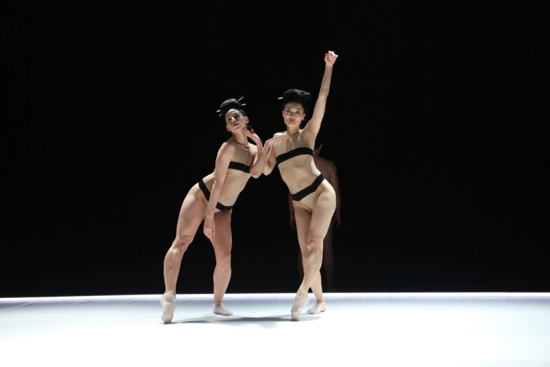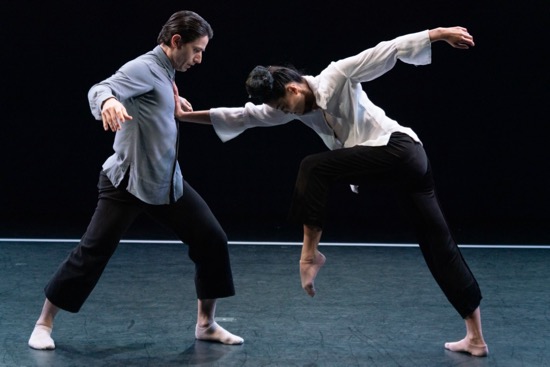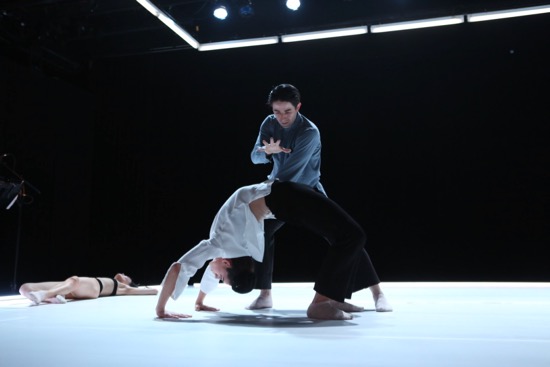
Anyone who has seen a Japanese Noh play will not forget it easily. The poetic speech, the masked characters and their slow, ceremonious behavior, the tiny details that expose a world. Karole Armitage has studied and thought about the form for many years, perhaps while performing in Merce Cunningham’s company or being the resident choreographer for the Ballet de Lorraine (among many other stints). Her fascinating You Took A Part of Me for Armitage Gone! Dance alludes to and converses with, a 15th-century “ghost play:” Nonomiya. Like a number of other Noh plays, it refers to episodes in Lady Murasaki’s 11th-century novel, The Tale of Genji—in particular, the love affair between Genji, a son of the Emperor, and the beautiful Lady Rokujo, whom he met at the Nonomiya Shrine. And the jealousy of Genji’s wife, Lady Aoi.
In New York Live Arts’ program for You Took A Part of Me, which premiered last April at Japan Society, the characters are listed like this: The Ghost (I), Her Double (Me), Her Lover, and Koken. The segments they populate are Introduction, Memory Duet, Abandonment, Hijacked Mind, Battle with Self, Attachments, Liberation, and Conclusion. All this in an hour.
The action takes place on a large, raised platform designed by Clifton Taylor; the performers must walk into view and climb a few steps in order to make their entrances. Above it hangs a frame of the same size. A stool sits on a small extension at one side. This area shows something never seen by spectators of Noh drama: the “mirror room” where preparations occur. It is where Alonso Guzman as the koken (a sort of prop man usually ignored by Noh performers) helps Megumi Eda (The Ghost) roll her long, shaggy black wig into a bun and anchor it with two chopsticks; he holds up a mirror for her to see the effect. We never see Guzman’s entire face: the top of a loose-fitting, black turtle-neck that reached to just below his eyes.

As the piece begins, Eda and Sierra French (Her Double), identically clad in white jackets and loose white pants, wear those wigs (created by Danilo), which are connected to each other by long, thick bunches of hair. Therefore the two move carefully, mostly in unison, the physical bond hinting at their spiritual relationship to each other—both Eda’s other self and her rival for the love of the male performer (Cristian Laverde-Koenig). Gradually, they lean away from each other, so that the shared locks of hair begin to pull apart. Reiko Yamada’s music has begun. It is sparse, often sudden; flute calls, murmuring voices, distant bells are just some of the haunting acoustic and electronic sounds.

Photo: Steven Pisano
Eda, who has worked with Armitage for years, is an extraordinary performer—thoughtful, supple. She makes every smooth complication of her body and limbs look like the flow of ideas (the press material mentions that the “sinuous movement is based on the curvilinear paths of classical Japanese calligraphy.”) Laverde-Koenig, wearing black pants and a blue-gray top, enters the stage as if she has summoned him from the darkness of her memories. He reaches just above her head without touching it, as if it’s he who is reanimating her; he seems to sniff her before lifting her high. Pauses stud their separations and comings together.
Then, in a startling moment, the koken grasps each one’s clothing in turn and in split seconds undresses one, then the other. Peter Speliopoulos’s costumes now consist only of black bands—one for Laverde-Koenig, two for Eda—held together by invisible flesh-colored netting. Thus attired, they twine slowly together in complex ways, as if to explore and test the erotic knots that arise. Throughout the duet, their faces remain immobile enough to suggest masks, although the intensity of their gaze never slackens.

When Laverde-Koenig leaves, Eda collapses and crashes resoundingly to the floor, yet it’s the smaller gestures that express what this memory of love and its abandonment have awakened: her mouth opens in a silent cry, she clasps her breasts, she bites one hand. The Koken re-garbs the Lover for another duet, this one with French. You can assume that their coming together is being recalled by Eda, lying immobile on the floor (this is the section titled “Hijacked Mind”). Laverde-Koenig’s gestures seem almost to be animating or guiding his partner without always touching her; yet their dancing also has the air of a formal conversation.

When these women have been stripped of outer clothing again, he leaves them to bicker. The music amplifies the impression that these inextricably paired women—the rememberer and the remembered or repressed part of her—are spitting at each other. Yet they often move as mirror images. When Laverde-Koenig returns, the three intertwine in increasingly knotted positions, mostly on the floor, with one of the participants occasionally assuming brief power.
It is difficult to express the intensity of the action in words: its eroticism, its slowness, its formality, the repressed rage that permeates it. The blackouts in Taylor’s lighting, the sudden contrasts in Yamada’s music, plus the deliberate, unhurried entrances and exits build You Took A Part of Me’s dream-like atmosphere. The fact that the title capitalizes the letter “a” suggests that what we’ve been watching is one woman’s internal struggle made manifest on the stage, and the source of it: the man who incited that cleavage of self. As a ghost, she lingers between life and eternal rest, haunting her memories.
In the end, she is liberated—free to leap away from the floor, free of her recollections. She pulls the sticks out of her hair and lets it fall. She backs away from us. Will her spirit now be at rest?
